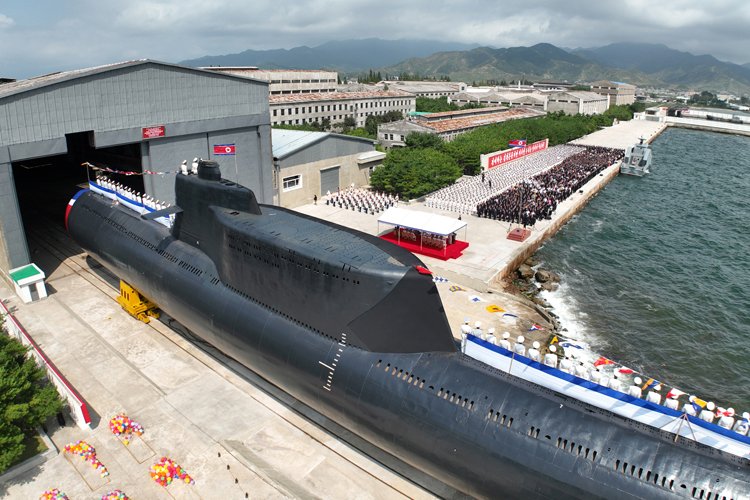As North Korea launched a new tactical nuclear attack submarine capable of launching ten nuclear-tipped missiles, the South Korean military is developing a high-power laser that can intercept a large number of unmanned aerial vehicles or cruise missiles.
This comes amid Pyongyang testing and introducing new types of drones, ballistic & cruise missiles at an unprecedented rate while Seoul ramps up its military cooperation with the US and conducts massive naval and air exercises.
The submarine, a rebuilt and modified Soviet-origin Romeo-class boat, according to Naval News, has two rows of five missile hatches inside a section built into the sail. The bow has been shortened reshaped, and the diving planes moved to the sail.
North Korean news agency KCNA quoted leader Kim Jong-un saying that a nuclear-capable navy was an urgent task, promising to build more underwater and surface weapons for the navy.
The announcement by South Korea’s Defense Acquisition Program Administration (DAPA) on September 7 about holding the Advanced Technology Project Management Committee meeting that commissioned to develop the high-powered laser comes around the same time.
This marks the biggest military build-up in the Korean Peninsula in history, at a time when two other flashpoints in far east Asia and the western Pacific have also become active – the Taiwan Straits and the South China Sea (SCS).
North Korea’s Heavily Modified Soviet-Era Submarine
Kim, who attended the launch ceremony, said, “The submarine-launching ceremony heralded the beginning of a new chapter for bolstering up the naval force of the DPRK.”
Assigned the hull number Submarine No. 841 and named Hero Kim Kun Ok after – a historical figure North Korean figure – it will function as “one of the core underwater offensive means of the naval force.”
Kim subsequently announced developing existing submarines into nuclear weapons-armed attack submarines and developing nuclear-powered submarines as well.
“Achieving a rapid development of our naval forces…is a priority that cannot be delayed given…the enemies’ recent aggressive moves and military acts,” Kim added. While the type of missile the submarine will carry is unclear, it can be assumed to be one of the submarine-launched ballistic missiles (SLBM) and cruise missiles North Korea has recently test-fired.

It also implies that Pyongyang has managed to develop miniaturized nuclear warheads to be fitted on the relatively smaller missiles on the submarines.
This, too, however, remains unclear but would most likely be a key goal if the North resumes nuclear testing. According to Reuters, North Korea has a large submarine fleet, but only the experimental ballistic missile submarine 8.24 Yongung (August 24 Hero) is known to have launched a missile.
Nuclear Threat Initiative states that North Korea maintains one of the largest submarine fleets in the world, with estimates ranging from 64 to 86 vessels.
“This is likely intended to field the navalized version of the KN23, which they’ve acknowledged as a delivery system for their compact nuclear warhead,” Ankit Panda of the Carnegie Endowment for International Peace was quoted in the Reuters report, citing the short-range SLBM that the North has tested.
Aimed At US Warships & Aircraft Carriers?
The commissioning of the submarine also comes after North Korea launched several cruise missiles into the sea late last week. South Korea’s military detected the launches off the North’s west coast, the South’s Joint Chiefs of Staff said in a statement.
The launches came two days after the US and South Korean militaries concluded their 11-day training exercises. While Pyongyang perceives the exercises as a rehearsal for invasion, Washington and Seoul officials maintain their drills are defensive.
Cruise missiles carrying nuclear warheads are a particular threat since they aren’t prohibited by United Nations Security Council (UNSC) resolutions. At a techno-tactical level, too, they pose a challenge they fly at a lower altitude to evade radar detection.
The terrain in the Korean Peninsula military situation being maritime and the US Navy (USN) being the leading service to participate in a war there, it can be safely assumed that the targets for North Korean cruise missiles would be US warships and aircraft carriers.
South Korea’s Laser Weapon
According to reports, South Korean scientists aim to achieve an output of more than 300 kW (kilowatts). Such a power output can intercept large unmanned aerial vehicles, rocket launchers, and subsonic-guided missiles.
The induction of the weapon is still far away since it has only just been announced, with DAPA itself clarifying that it plans to begin development next year after first conducting a “feasibility study.”
Directed Energy Weapons (DEW) like lasers have a particular advantage over conventional kinetic ammunition since they can be accurate and engage multiple targets simultaneously. This is subject to a high amount and stable electricity supply.
Conversely, it cannot be the sole weapon for missile defense and can only complement existing conventional weapon systems. Regular missile defenses can be tasked with engaging certain types of missiles and the DEWs another, dividing the role between them and not overburdening one particular system.
Seoul presently does have a laser DEW but has an output of 20 kW, suitable for only small drones. It was inducted into service in April 2022 and received a ‘decision of suitability for combat’ from the Ministry of National Defense.
- The author can be reached at satamp@gmail.com
- Follow EurAsian Times on Google News